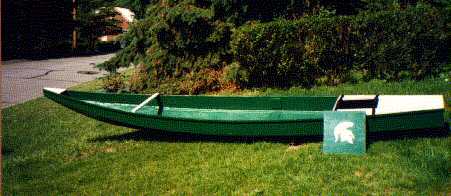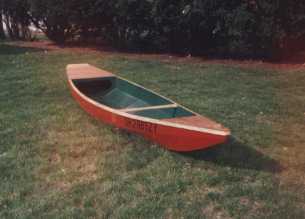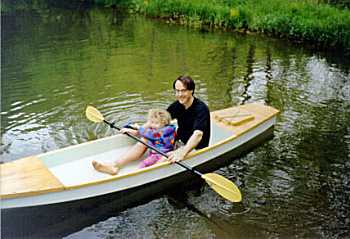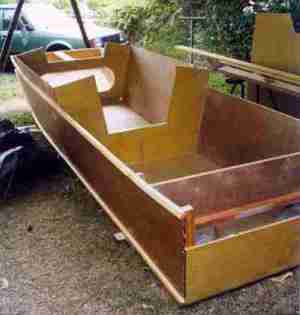
Bob Hoyle, 73 years young, paddles his deckless Larsboat in Florida. Looks a lot like a Toto.
Contents:
Contact info:
Jim Michalak
118 E Randall,
Lebanon, IL 62254Send $1 for info on 20 boats.
Jim Michalak's Boat Designs
118 E Randall, Lebanon, IL 62254
A page of boat designs and essays.
(15mar02) This issue will discuss cutting bevels. In the 1apr02 issue I boil some wood.
ON LINE CATALOG OF MY PLANS...
... can now be found at Duckworks Magazine. You order with a shopping cart set up and pay with credit cards or by Paypal. Then Duckworks sends me an email about the order and then I send the plans right from me to you. The prices there are $6 more than ordering directly from me by mail in order to pay Duckworks and credit charges. The on line catalog has more plans offered, about 65, than what I can put in my paper catalog and the descriptions can be more complete and can have color photos.

|
Left:
Bob Hoyle, 73 years young, paddles his deckless Larsboat in Florida. Looks a lot like a Toto.
|
|
|
BULKHEAD BEVELS
I don't know if there are many topics that cause more confusion to boatbuilders than bevels at bulkheads and transoms. Some slant in and some slant out. Sometimes you can measure them right off the lines drawing but often you can't. To a certain extent the subject has become less important with taped seam construction, but many glue and nail boats are still being built and as you will see, I like to use nail and glue construction in the very early stages of building a taped seam boat because it allows a quick and solid alignment when that is most appreciated, as shown in this photo of Dale Dagger in Nicaragua with a Toto project. At this stage the hull has used conventional construction which required cutting bevels on some of the elements. Dale asked for clarification on one of them.

I did update the Toto drawing to include the full sized bevel drawings shown below. One is for the side edges of bulkhead 10 and the other is for the side edges of the transom.

When I figure out the dimensions of the plywood piece that forms the shape of the bulkhead or transom, I take its dimensions off my lines drawing as if the piece had no thickness.
But the real panels do have thickness. So I rig it such that one face of the panel lies on the plane where I took the panel dimensions and mark that face "Dimensions to Here". Now if the side or bottom panels are sweeping in or out from the dimensioned face, then the other face of the bulkhead or transom will need to be smaller or larger than the dimensioned face.
Let's take the case where the adjacent panels are sweeping outward from the dimensioned face. We'll call this one an "outy". The transom bevel on Toto is as outy. The dimensioned face of the Toto transom is on the plane of the end of the boat and the transom's forward face needs to be slightly larger than the dimensioned face to allow for the outward sweep of the side panels, which measures 10 degrees at that point. How much larger? The Toto transom is supposed to be 1/4" plywood with a 3/4" thick framing stick, for a total of 1" thick. So to allow for the 10 degree bevel each side needs to have 1" X tan10 = .176" extra material which is 3/16" to most of us. But when I build one of these outy's myself, I pay no attention to that extra thickness. See the figure below to see how I do it on my own boats.

I've found the best tool to cut straight bevels is a table saw. First I cut the side sticks on the table saw to the correct bevel. Then I cut the transom (or bulkhead) panel out of plywood to the dimensions with no bevel, just a square cut. Then I glue and nail the beveled sticks to the plywood piece such that a straight edge along the beveled stick will just kiss the "Dimensions to Here" edge. That's it. I haven't fussed with that "extra material needed" measurement at all. This gives a nice straight edge to the right dimensions and it doesn't really get involved with thicknesses - if you use thicker or thinner wood than specified it will still fit.
"But," you say,"there's a little triangular area on the edge of the plywood that isn't right." True. I fill that with glue when the panel is glued and nailed to the side. That triangle isn't very big. On this 10 degree bevel it would max at .045". No problem. To me the glue there is really a hope of sealing the grain on the edge of the plywood, not a strength issue since a lot of that ply edge will be end grain anyway and about useless for glue strenght.
Now let's talk about the inny. Bulkhead 10 on Toto is an inny. (I suspect the trouble Dale had was that he made this one an outy the first try.) The basic dimensions of bulkhead 10 were taken 10' aft of the bow tip of the boat. That is the actual front face of the bulkhead, the face marked "Dimensions to Here". At that point the sides are sweepin inward 7 degrees as they go aft. This bulkhead is also 1/4" plywood with 3/4" sticks for a total of 1" thick. So the aft face of the bulkhead needs to be 1 X tan7=.12" smaller on each side edge than the front side edges.

Innys are a little easier to picture. You could make all the edges square to the basic dimensions and then run them through a saw set to the proper bevel to shave off the extra material. I used to do them that way and still do on occasion. The problem I have is that I use a bandsaw for this which doesn't care to cut straight. And a large bulkhead is a beast to run through the saw all at once. You could try a saber saw or circular saw set to the proper bevel if you think you are good enough at it to keep the blade just kissing the edge marked "Dimensions to Here". I' not.
So I've gone to making the inny bulkhead the same way as I make an outy. First I prebevel the framing sticks with a table saw. Then I cut the plywood panel to shape with no bevel, just a square cut. Then I glue and nail the sticks to the sides of the panel. If the bevel is severe I do try to line up the face of the bevel stick with the "Dimensions to Here" edge of the plywood. Then I will have a small triangle of plywood protruding from the beveled face. I can trim that off later. In the case of a small bevel, I don't do that. I just line up the stick with the back edge of the panel. When I assemble it to the sides there will be a little triangle to fill with glue again. And the panel will be slightly wider than what the lines call for. In the case of Toto's bulkhead 10 the error would be .25" X tan7 = .03". Nothing to worry about.
NEXT TIME...
I'll boil some glued wood and see what happens.
TOTO
TOTO, DOUBLE PADDLE CANOE, 13' X 30", 45 POUNDS EMPTY

The photo above is from Tom Raidna.
Toto has been my most successful design. Initially she was an experiment to test a new bow shape - a deep V bow that blends into a multichine well aft. There's a twist in the bow bilge panels and at the time I didn't know how to expand those panels on the drawing board. So I built her without them and then sized them by cut and fit. Then I recorded the shapes on the prints. Nowadays this sort of twisted paned expansion is routine on a computer to great accuracy (provided the input is accurate).
The boat is an easy prefab job from two sheets of 5MM lauan underlayment, still very cheap at maybe $12 a sheet from the lumberyard until the rain forests are gone. Marc Smith came to the 1994 Midwest Messabout with tow of these Totos strapped to the roof of his Birdwatcher. They were built by two twelve year old girls under Marc's guidance. Marc said the girls did all the work including using the power tools. And they paddled around the Messabout in them.
It's fun to compare Toto with the typical minimal dink because they usually come from the same pile of stuff and labor. Toto covered the 6000 foot long dam at Carlyle lake in 14 minutes with a moderate paddling effort for 4-1/2 mph. She's more seaworthy but she's wetter when pressed because of paddle splash. She has a buoyancy/storage chamber aft. It will keep your shoes and stuff dry while you splash around and I believe it has about 180 pounds of buoyancy volume if the hatch cover stays watertight. (But you can't "self rescue" in any boat like this without very special training. It's best to stay within a short swim or wade to shallow water.) The open cockpit is large enough to allow sleeeping inside, as I have done many times. She's shaped for easy cartopping. In good conditions she'll paddle two adults. The long lean bow seems to ignore an overload, unlike plumb bows which can become cranky when immersed. She'll take you through some very rough stuff if you are solo. But the dinks have their place too. They can have sailing stability and many will find their elevated seating more comfortable. By the way, a boat like Piragua with a simple wide flat bottom won't be as fast or as seaworthy as Toto, but you might be able to stand up in Piragua. Don't expect to do that in a boat like Toto.
I've rounded up some more Toto photos. Here are three by John Mulligan on Long Island. These three and Raidna's look to me to be build per blueprint. (I'd sit a little farther forward myself.)

Dale Dagger finished his Toto and here he rides a wave in Nicaragua.

Here is Bob Hoffert's Toto in Ohio, maybe the first boat after mine. Looks like he has added a fore deck and put a big access hole in the aft bulkhead. (Remember that the aft storage box is also supposed to be an emergency buoyancy air box to help save your butt in a capsize.)

Here is John Ellwood's Toto in Massachusetts. Crowned fore and aft decks and another access hole in the aft bulkhead, although this one appears to have a cover.

Here is Garth Battista of Breakaway Books with a small foredeck and some good company:

Here is Don Duquet of mims.com with good company getting ready to watch a space shuttle launch:

Here is Bob Cole's delux Toto, totally decked with watertight storage in both ends way up in northern Canada:

And the fanciest Toto ever by Dean Souza in Washington, with watertight storage fore and aft, fancy coamings, cleats and line chocks, even the national flag flying on the stern!

Bob Hoyle in Florida built this Toto before he made the deckless Larsboat shown earlier.

And Al Fittipaldi made this Toto and got a picture of it in Woodenboat magazine!

Plans come with complete instructions including the details of taped seam construction and a drawing of a simple paddle that works. (Marc Smith's girls used double paddles made from old vaulting poles with plywood blades bolted on. I tried their boats and paddles and they were quite good.) No jigs or lofting required. Blueprints plus instructions are $15.
Prototype News
Some of you may know that in addition to the one buck catalog which now contains 20 "done" boats, I offer another catalog of 20 unbuilt prototypes. The buck catalog has on its last page a list and brief description of the boats currently in the Catalog of Prototypes. That catalog also contains some articles that I wrote for Messing About In Boats and Boatbuilder magazines. The Catalog of Prototypes costs $3. The both together amount to 50 pages for $4, an offer you may have seen in Woodenboat ads. Payment must be in US funds. The banks here won't accept anything else. (I've got a little stash of foreign currency that I can admire but not spend.) I'm way too small for credit cards.
Here are the prototypes abuilding that I know of:
Electron: The California Electron is coming along. Right now a four cycle 2 hp outboard has been purchased so the original electric idea may wait a while.


Mayfly: The prototype of the original 14' Mayfly is finished in New York state. Here it is on its first sail (Long Island Sound).

A Campjon is ready for paint in exotic Queensland, Australia. Another is underway in New York with an enlarged cuddy.

AN INDEX OF PAST ISSUES
Herb builds AF3 (archived copy)
Hullforms Download (archived copy)
Plyboats Demo Download (archived copy)
Brokeboats (archived copy)